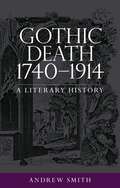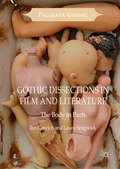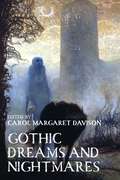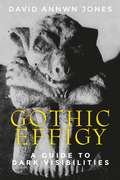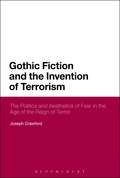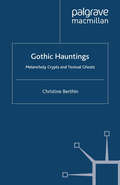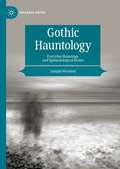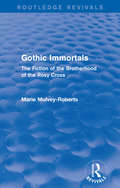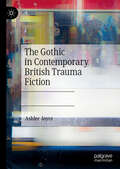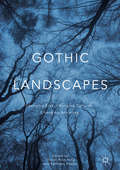- Table View
- List View
Gothic death 1740–1914: A literary history (PDF)
by Andrew SmithGothic death 1740-1914 explores the representations of death and dying in Gothic narratives published between the mid-eighteenth century and the beginning of the First World War. The book investigates how eighteenth century Graveyard Poetry and the tradition of the elegy produced a version of death that underpinned ideas about empathy and models of textual composition. Later accounts of melancholy, as in the work of Ann Radcliffe and Mary Shelley, emphasise the literary construction of death. The shift from writing death to interpreting the signs of death is explored in relation to the work of Poe, Emily Brontë and George Eliot. A chapter on Dickens examines the significance of graves and capital punishment during the period. A chapter on Haggard, Stoker and Wilde explores conjunctions between love and death and a final chapter on Machen and Stoker explores how scientific ideas of the period help to contextualise a specifically fin de siècle model of death.
Gothic death 1740–1914: A literary history
by Andrew SmithGothic death 1740-1914 explores the representations of death and dying in Gothic narratives published between the mid-eighteenth century and the beginning of the First World War. The book investigates how eighteenth century Graveyard Poetry and the tradition of the elegy produced a version of death that underpinned ideas about empathy and models of textual composition. Later accounts of melancholy, as in the work of Ann Radcliffe and Mary Shelley, emphasise the literary construction of death. The shift from writing death to interpreting the signs of death is explored in relation to the work of Poe, Emily Brontë and George Eliot. A chapter on Dickens examines the significance of graves and capital punishment during the period. A chapter on Haggard, Stoker and Wilde explores conjunctions between love and death and a final chapter on Machen and Stoker explores how scientific ideas of the period help to contextualise a specifically fin de siècle model of death.
Gothic Dissections in Film and Literature: The Body in Parts (Palgrave Gothic)
by Ian Conrich Laura SedgwickThis is the first book-length study to systematically and theoretically analyse the use and representation of individual body parts in Gothic fiction. Moving between filmic and literary texts and across the body—from the brain, hair and teeth, to hands, skin and the stomach—this book engages in unique readings by foregrounding a diversity of global representations. Building on scholarly work on the ‘Gothic body’ and ‘body horror’, Gothic Dissections in Film and Literature dissects the individual features that comprise the physical human corporeal form in its different functions. This very original and accessible study, which will appeal to a broad range of readers interested in the Gothic, centralises the use (and abuse) of limbs, organs, bones and appendages. It presents a set of unique global examinations; from Brazil, France and South Korea to name a few; that address the materiality of the Gothic body in depth in texts ranging from the nineteenth century to the present; from Nikolai Gogol, Edgar Allan Poe, Roald Dahl and Chuck Palahniuk, to David Cronenberg, Freddy Krueger and The Greasy Strangler.
Gothic Documents: A sourcebook 1700–18
by Robert Miles E. J. CleryHow is it that the age of Enlightenment gave rise to the genre of the literary ghost story? What did the term 'Gothic' mean, when Horace Walpole used it in the subtitle of his experimental novel The Castle of Otranto? How did a type of writing which broke. Based on intensive research, it demonstrates the importance of a historical understanding of the genre, and will be influential in the development of Gothic studies.. It is prestigious and timely: Gothic is a highly active research area and has a growing presence in the university syllabus.. Clery and Miles are well-respected and much cited critics who have alredy published widely in this field.. This is a unique anthology filling an important gap in the market; an indispensible resource for students, teachers and scholars.
Gothic dreams and nightmares
by Carol DavisonGothic dreams and nightmares is an edited collection on the compelling yet under-theorised subject of Gothic dreams and nightmares ranging across more than two centuries of literature, the visual arts, and twentieth- and twenty-first century visual media. Written by an international group of experts, including leading and lesser-known scholars, it considers its subject in various national, cultural, and socio-historical contexts, engaging with questions of philosophy, morality, rationality, consciousness, and creativity.
Gothic dreams and nightmares
by Carol Margaret DavisonGothic dreams and nightmares is an edited collection on the compelling yet under-theorised subject of Gothic dreams and nightmares ranging across more than two centuries of literature, the visual arts, and twentieth- and twenty-first century visual media. Written by an international group of experts, including leading and lesser-known scholars, it considers its subject in various national, cultural, and socio-historical contexts, engaging with questions of philosophy, morality, rationality, consciousness, and creativity.
Gothic effigy: A guide to dark visibilities
by David Annwn JonesGothic effigy brings together for the first time the multifarious visual motifs and media associated with Gothic, many of which have never received serious study before. This guide is the most comprehensive work in its field, a study aid that draws links between a considerable array of Gothic visual works and artifacts, from the work of Salvator Rosa and the first illustrations of Gothic Blue Books to the latest Gothic painters and graphic artists. Currently popular areas such as Gothic fashion, gaming, T.V. and film are considered, as well as the ghostly images of magic lantern shows. This groundbreaking study will serve as an invaluable reference and research book. In its wide range and closely detailed descriptions, it will be very attractive for students, academics, collectors, fans of popular Gothic culture and general readers.
Gothic effigy: A guide to dark visibilities
by David Annwn JonesGothic effigy brings together for the first time the multifarious visual motifs and media associated with Gothic, many of which have never received serious study before. This guide is the most comprehensive work in its field, a study aid that draws links between a considerable array of Gothic visual works and artifacts, from the work of Salvator Rosa and the first illustrations of Gothic Blue Books to the latest Gothic painters and graphic artists. Currently popular areas such as Gothic fashion, gaming, T.V. and film are considered, as well as the ghostly images of magic lantern shows. This groundbreaking study will serve as an invaluable reference and research book. In its wide range and closely detailed descriptions, it will be very attractive for students, academics, collectors, fans of popular Gothic culture and general readers.
Gothic Fiction (Readers' Guides to Essential Criticism)
by Angela WrightWhat is the Gothic? Few literary genres have attracted so much praise and critical disdain simultaneously. This Guide returns to the Gothic novel's first wave of popularity, between 1764 and 1820, to explore and analyse the full range of contradictory responses that the Gothic evoked. Angela Wright appraises the key criticism surrounding the Gothic fiction of this period, from eighteenth-century accounts to present-day commentaries. Adopting an easy-to-follow thematic approach, the Guide examines:- contemporary criticism of the Gothic- the aesthetics of terror and horror - the influence of the French Revolution- religion, nationalism and the Gothic- the relationship between psychoanalysis and the Gothic- the relationship between gender and the Gothic.Concise and authoritative, this indispensable Guide provides an overview of Gothic criticism and covers the work of a variety of well-known Gothic writers, such as Horace Walpole, Ann Radcliffe, Matthew Lewis and many others.
Gothic Fiction (Readers' Guides to Essential Criticism)
by Angela WrightWhat is the Gothic? Few literary genres have attracted so much praise and critical disdain simultaneously. This Guide returns to the Gothic novel's first wave of popularity, between 1764 and 1820, to explore and analyse the full range of contradictory responses that the Gothic evoked. Angela Wright appraises the key criticism surrounding the Gothic fiction of this period, from 18th century accounts to present-day commentaries. Adopting an easy-to-follow thematic approach, the Guide examines:- Contemporary criticism of the Gothic- The aesthetics of terror and horror - The influence of the French Revolution- Religion, nationalism and the Gothic- The relationship between psychoanalysis and the Gothic- The relationship between gender and the Gothic.Concise and authoritative, this indispensable Guide provides an overview of Gothic criticism and covers the work of a variety of well-known Gothic writers, such as Horace Walpole, Ann Radcliffe, Matthew Lewis and many others.
Gothic Fiction and the Invention of Terrorism: The Politics and Aesthetics of Fear in the Age of the Reign of Terror
by Joseph CrawfordChoice Outstanding Academic Title 2014This book examines the connections between the growth of'terror fiction' - the genre now known as 'Gothic' - in the late eighteenthcentury, and the simultaneous appearance of the conceptual origins of'terrorism' as a category of political action. In the 1790s, Crawford argues, fourinter-connected bodies of writing arose in Britain: the historical mythology ofthe French Revolution, the political rhetoric of 'terrorism', the genre ofpolitical conspiracy theory, and the literary genre of Gothic fiction, known atthe time as 'terrorist novel writing'. All four bodies of writing drew heavilyupon one another, in order to articulate their shared sense of the radical andmonstrous otherness of the extremes of human evil, a sense which was quite newto the eighteenth century, but has remained central to the ways in which wehave thought and written about evil and violence ever since.
Gothic Fiction and the Invention of Terrorism: The Politics and Aesthetics of Fear in the Age of the Reign of Terror
by Joseph CrawfordChoice Outstanding Academic Title 2014This book examines the connections between the growth of'terror fiction' - the genre now known as 'Gothic' - in the late eighteenthcentury, and the simultaneous appearance of the conceptual origins of'terrorism' as a category of political action. In the 1790s, Crawford argues, fourinter-connected bodies of writing arose in Britain: the historical mythology ofthe French Revolution, the political rhetoric of 'terrorism', the genre ofpolitical conspiracy theory, and the literary genre of Gothic fiction, known atthe time as 'terrorist novel writing'. All four bodies of writing drew heavilyupon one another, in order to articulate their shared sense of the radical andmonstrous otherness of the extremes of human evil, a sense which was quite newto the eighteenth century, but has remained central to the ways in which wehave thought and written about evil and violence ever since.
Gothic Forensics: Criminal Investigative Procedure in Victorian Horror & Mystery (Semiotics and Popular Culture)
by Michael ArntfieldMichael Arntfield interrogates the legacy of Victorian-era crime fiction and Gothic horror on investigative forensic methods used by police today.
Gothic forms of feminine fictions
by Susanne BeckerGothic forms of feminine fictions is a study of the powers of the Gothic in late twentieth-century fiction and film. Susanne Becker argues that the Gothic, two hundred years after it emerged, exhibits renewed vitality in our media age with its obsession for stimulation and excitement.
Gothic Hauntings: Melancholy Crypts and Textual Ghosts
by Christine BerthinWhat is buried in the crypts of the Gothic? Building on psychoanalytic research on haunting, cryptonymy and melancholy, as well as on French philosophies of language, this book explores how haunting is not just a Gothic narrative device but the symptom of an impossibility of representation and of an irreparable loss at the heart of language.
Gothic Hauntology: Everyday Hauntings and Epistemological Desire (Palgrave Gothic)
by Joakim WrethedThis book provides a theoretically informed account of Gothic Hauntology. It is distinctive foremost in two ways. It shows hauntology at work in modern as well as older gothic narratives and it has a unique focus on everyday gothic as well as everyday hauntology. The chapters perform a historical circle going from Munro to Poe and then back again, offering novel readings of works by well-known authors that are contextualized under the umbrella of the theme. Anchored in a well-known topic and genre, but with a specific phenomenological framework, this book will be of interest to both students and more advanced scholars.
Gothic Histories: The Taste for Terror, 1764 to the Present
by Clive BloomIn the middle of the eighteenth century the Gothic became the universal language of architecture, painting and literature, expressing a love not only of ruins, decay and medieval pageantry, but also the drug-induced monsters of the mind. By explaining the international dimension of Gothicism and dealing in detail with German, French and American authors, Gothic Histories demonstrates the development of the genre in every area of art and includes original research on Gothic theatre, spiritualism, 'ghost seeing' and spirit photography and the central impact of penny-dreadful writers on the genre, while also including a host of forgotten or ignored authors and their biographies. Gothic Histories is essential reading for anyone interested in the history of the Gothic and its literary double, the horror genre, leading the reader from their origins in the haunted landscapes of the Romantics through Frankenstein and Dracula to the very different worlds of Hannibal Lecter and Goth culture. Comprehensive and up-to-date, it is a fascinating guide to the Gothic and horror in film, fiction and popular culture.
Gothic Horror: A Guide for Students and Readers
by Clive BloomThis highly accessible anthology of Gothic writings and criticism provides an essential guide to the genre. The second edition of this critically acclaimed book has been thoroughly revised to include material from the early gothic and a fresh set of contemporary essays, with a supporting timeline and thought provoking introductory material.
Gothic Horror: A Reader’s Guide from Poe to King and Beyond
by Clive BloomThis anthology presents classic and contemporary accounts of modern gothic horror writing from Edgar Allan Poe, H.P. Lovecraft, Robert Bloch, Stephen King, Clive Barker and many other authors, as well as essays from current literary scholars, providing an essential guide to the genre and the variety of approaches possible when discussing the literature of terror. The whole volume is introduced by Clive Bloom, who offers an outline of the genre and situates it in its social and cultural context.
Gothic Immortals (Routledge Revivals): The Fiction of the Brotherhood of the Rosy Cross
by Marie Mulvey-RobertsFirst published in 1990, this book represents the first full-length study of into the group of novels designated ‘Rosicrucian’ and traces the emergence of this distinct fictional genre, revealing a continuous occult tradition running through seemingly diverse literary texts. Taking the Enlightenment as a starting point, the author shows how the physician’s secular appropriation of the idea of eternal life, through the study of longevity and physical decay, attracted writers like William Godwin. It focuses on the bodily immortality of the Rosicrucian hero and investigates the novels of five major writers — Godwin, Percy Bysshe Shelley, Mary Shelley, Maturin, and Bulwer-Lytton.
Gothic Immortals (Routledge Revivals): The Fiction of the Brotherhood of the Rosy Cross
by Marie Mulvey-RobertsFirst published in 1990, this book represents the first full-length study of into the group of novels designated ‘Rosicrucian’ and traces the emergence of this distinct fictional genre, revealing a continuous occult tradition running through seemingly diverse literary texts. Taking the Enlightenment as a starting point, the author shows how the physician’s secular appropriation of the idea of eternal life, through the study of longevity and physical decay, attracted writers like William Godwin. It focuses on the bodily immortality of the Rosicrucian hero and investigates the novels of five major writers — Godwin, Percy Bysshe Shelley, Mary Shelley, Maturin, and Bulwer-Lytton.
The Gothic in Contemporary British Trauma Fiction
by Ashlee JoyceThis book examines the intersection of trauma and the Gothic in six contemporary British novels: Martin Amis’s London Fields, Margaret Drabble’s The Gates of Ivory, Ian McEwan’s Atonement, Pat Barker’s Regeneration and Double Vision, and Kazuo Ishiguro’s Never Let Me Go. In these works, the Gothic functions both as an expression of societal violence at the turn of the twenty-first century and as a response to the related crisis of representation brought about by the contemporary individual’s highly mediated and spectatorial relationship to this violence. By locating these six novels within the Gothic tradition, this work argues that each text, to borrow a term from Jacques Derrida, “participates” in the Gothic in ways that both uphold the paradigm of “unspeakability” that has come to dominate much trauma fiction, as well as push its boundaries to complicate how we think of the ethical relationship between witnessing and writing trauma.
Gothic incest: Gender, sexuality and transgression
by Jenny DiPlacidiThis electronic version has been made available under a Creative Commons (BY-NC-ND) open access license. The first full-length study of incest in the Gothic genre, this book argues that Gothic writers resisted the power structures of their society through incestuous desires. It provides interdisciplinary readings of incest within father-daughter, sibling, mother-son, cousin and uncle-niece relationships in texts by authors including Emily Brontë, Eliza Parsons, Ann Radcliffe and Eleanor Sleath. The analyses, underpinned by historical, literary and cultural contexts, reveal that the incest thematic allowed writers to explore a range of related sexual, social and legal concerns. Through representations of incest, Gothic writers modelled alternative agencies, sexualities and family structures that remain relevant today.
Gothic incest: Gender, sexuality and transgression
by Jenny DiPlacidiThe first full-length study of incest in the Gothic genre, this book argues that Gothic writers resisted the power structures of their society through incestuous desires. It provides interdisciplinary readings of incest within father-daughter, sibling, mother-son, cousin and uncle-niece relationships in texts by authors including Emily Brontë, Eliza Parsons, Ann Radcliffe and Eleanor Sleath. The analyses, underpinned by historical, literary and cultural contexts, reveal that the incest thematic allowed writers to explore a range of related sexual, social and legal concerns. Through representations of incest, Gothic writers modelled alternative agencies, sexualities and family structures that remain relevant today.
Gothic Landscapes: Changing Eras, Changing Cultures, Changing Anxieties
by Sharon Rose Yang Kathleen HealeyThis book is about the ways that Gothic literature has been transformed since the 18th century across cultures and across genres. In a series of essays written by scholars in the field, the book focuses on landscape in the Gothic and the ways landscape both reflects and reveals the dark elements of culture and humanity. It goes beyond traditional approaches to the Gothic by pushing the limits of the definition of the genre. From landscape painting to movies and video games, from memoir to fiction, and from works of different cultural origins and perspectives, this volume traverses the geography of the Gothic revealing the anxieties that still haunt humanity into the twenty-first century.
